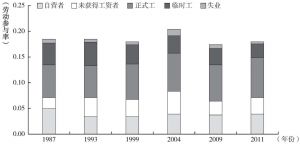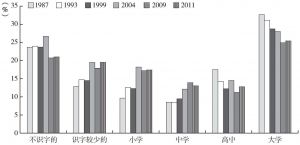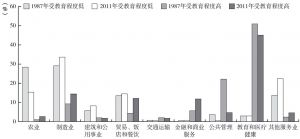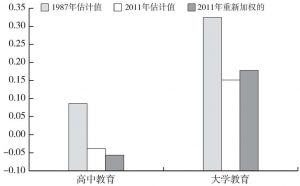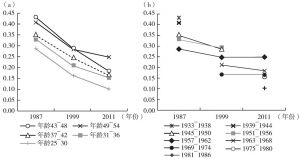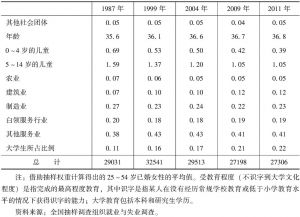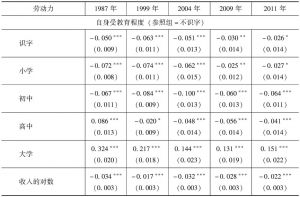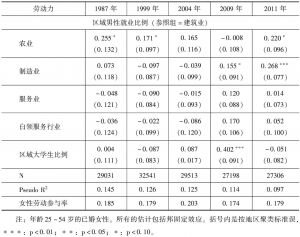- Afridi,F.,A.Mukhopadhyay,and S.Sahoo. 2012. “Female Labour Force Participation and Child Education in India:The Effect of the National Rural Employment Guarantee Scheme.” IZA Discussion Papers Series,No.6593.
- Ai,Chunrong,and Edward C.Norton. 2003. “Interaction Terms in Logit and Probit Models.” Economics Letters 80(1):123-129.
- Anderson,S. 2003. “Why Dowry Payments Declined with Modernization in Europe but Are Rising in India.” Journal of Political Economy 111(2):269-310.
- Anderson,S.,and M.Eswaran. 2009. “What Determines Female Autonomy?Evidence from Bangladesh.” Journal of Development Economics 90(2):179-191.
- Attanasio,O.,H.Low,and V.Sánchez-Marcos. 2005. “Female Labor Supply as Insurance against Idiosyncratic Risk.” Journal of the European Economic Association 3(2-3):755-764.
- Azam,M.,and G.G.Kingdon. 2013. “Are Girls the Fairer Sex in India?Revisiting Intra-Household Allocation of Education Expenditure.” World Development 42:143-164.
- Banerjee,A.,E.Duflo,M.Ghatak,and J.Lafortune. 2013. “Marry for what?Caste and Mate Selection in Modern India.” American Economic Journal:Microeconomics 5(2):33-72.
- Behrman,J.R.,A.D.Foster,M.R.Rosenzweig,and P.Vashishtha 1999. “Women’s Scholling,Home Teaching,and Economic Growth.” Journal of Political Economy 107(4):682-714.
- Bertrand,M.,R.Hanna,and S.Mullainathan. 2010. “Affirmative Action in Education:Evidence from Engineering College Admissions in India.” Journal of Public Economics 94:16-29.
- Bhalotra,S.,and M.Umaña-Aponte. 2010. “The Dynamics of Women’s Labor Supply in Developing Countries.” IZA Discussion Paper Series No.4879.
- Blau,F.D.,and L.M.Kahn. 2007. “Change in the Labor Supply Behavior of Married Women:1980-2000.” Journal of Labor Economics 25(3):393-438.
- Blinder,A.S. 1973. “Wage Discrimination:Reduced Form and Structural Estimates.” Journal of Human Resources 8(4):436-455.
- Bloom,D.E. 2011. “Population Dynamics in India and Implications for Economic Growth.” PGDA Working Paper No.65,Harvard School of Public Health.
- Bloom,D.E.,and J.G.Williamson. 1998. “Demographic Transitions and Economic Miracles in Emerging Asia.” World Bank Economic Review 12(3):419-55.
- Blundell,R.,and T.MaCurdy. 1999. “Labor Supply:A Review of Alternative Approaches.” In:O.Ashenfelter,and D.Card,eds.,Handbook of Labor Economics,1st ed.,vol.3,chap.27,1559-1695,New York:Elsevier.
- Boserup,E. 1970. Women’s Role in Economic Development. London:Earthscan.
- Bosworth,B.,and S.M.Collins. 2008. “Accounting for Growth:Comparing China and India.” Journal of Economic Perspectives 22(1):45-66.
- Chen,M.,and J. .1992. “Widows and Health in Rural North India.” 27(43-44):24-31.
- Das,M.B.,and S.Desai. 2003. “Why Are EducatedWomen Less Likely to be Employed in India?Testing Competing Hypotheses.” Social Protection Discussion Paper Series,No.313. Washington,DC:World Bank.
- Deaton,A. 2003. “Prices and Poverty in India,1987-2000.” Economic and PoliticalWeekly 38:362-68.
- Desai,S.,A.Dubey,B.L.Joshi,M.Sen,A.Shariff,and R.Vanneman. 2009. “India Human Development Survey(IHDS)[Computer file].” ICPSR22626-v2. Ann Arbor,MI:Inter-university Consortium for Political and Social Research.
- Desai,S.,A.Dubey,B.L.Joshi,M.Sen,A.Shariff,and R.Vanneman. 2009. Human Development in India:Challenges for a Society in Transition. New Delhi:Oxford University Press.
- Eswaran,M.,B.Ramaswami,and W.Wadhwa. 2013. “Status,Caste,and the Time Allocation of Women in Rural India.” Economic Development and Cultural Change 61(2):311-333.
- Fairlie,R.W. 2006. “An Extension of the Blinder-Oaxaca Decomposition Technique to Logit and Probit Models.” IZA Discussion Paper Series,No.1917.
- Gaddis,I.,and S.Klasen. 2014. “Economic Development,Structural Change,and Women’s Labor Force Participation:A Re-Examination of the Feminization U Hypothesis.” Journal of Population Economics 27(3):639-681.
- Goldin,C. 1990. Understanding the Gender Gap:and Economic History of American Women. New York:Oxford University Press.
- Goldin,C. 1994. “The U-shaped Female Labor Force Function in Economic Development and Economic History.” NBERWorking Paper Series,No.4707.
- Heim,B.T. 2007. “The Incredible Shrinking Elasticities:Married Female Labor Supply,1978-2002.” Journal of Human Resources 42(4):881-918.
- Jensen,R. 2012. “Do Labor Market Opportunities Affect Young Women’s Work and Family Decisions:Experimental Evidence from India.” Quarterly Journal of Economics 127(2):753-92.
- Kijima,Y. 2006. Why Did Wage Inequality Increase?Evidence from Urban India 1983-99. Journal of Development Economics 81(1):97-117.
- Kingdon,G.G. 2007. “The Progress of School Education in India.” Oxford Review of Economic Policy 23(2):168-195.
- Klasen,S.,and F.Lamanna. 2009. “The Impact of Gender Inequality in Education and Employment on Economic Growth:New Evidence for a Panel of Countries.” Feminist Economics 15(3):91-132.
- Klasen,S.,and J.Pieters. 2013. “What Explains the Stagnation of Female Labor Force Participation in Urban India?” IZA Discussion Paper No.7597.
- Klasen,S.,and C.Wink. 2003. “‘Missing Women’:Revisiting The Debate.” Feminist Economics(2-3):263-99.
- Klonner,S.,and C.Oldiges. 2014. “Safety Net for India’s Poor or Waste of Public Funds?Poverty and Welfare in the Wake of the World’s Largest Job Guarantee Program.” University of Heidelberg Department of Economics Discussion Paper No.564.
- Kucera,D.,L.Roncolato,and E.Von Uexkull. 2012. “Trade Contraction and Employment in India and South Africa during the Global Crisis.” World Development 40(6):1122-1134.
- Lam,D.,and S.Duryea. 1999. “Effects of Schooling on Fertility,Labor Supply,and Investments in Children,with Evidence from Brazil.” Journal of Human Resources 34(1):160-192.
- Luke,N.,and K.Munshi. 2011. “Women as Agents of Change:Female Income and Mobility in India.” Journal of Development Economics 94(1):1-17.
- Mammen,K.,and C.Paxson. 2000. “Women’sWork and Economic Development.” Journal of Economic Perspectives 14(4):141-64.
- National Sample Survey Organisation. 2010. “Migration in India,2007-2008.” NSS Report No.533.
- NCEUS. 2007. “Report on Conditions of Work and Promotion of Livelihoods in the Unorganised Sector.” New Delhi,National Commission for Enterprises in the Unorganised Sector.
- Oaxaca,R. 1973. “Male-Female Wage Differentials in Urban Labor Markets.” International Economic Review 14(3):693-709.
- Oster,E.,and B.Millet Steinberg. 2013. “Do IT Service Centers Promote School Enrollment?Evidence from India.” Journal of Development Economics 104:123-135.
- Pieters,J. 2010. “Growth and Inequality in India:Analysis of an Extended Social Accounting Matrix.” World Development 38(3):270-281.
- Qian,N. 2008. “Missing Women and the Price of Tea in China:The Effect of Sex-Specific Earnings on Sex Imbalance.” Quarterly Journal of Economics 123(3):1251-1285.
- Rosenzweig,M.R.,and O.Stark. 1989. “Consumption Smoothing,Migration,and Marriage:Evidence from Rural India.” Journal of Political Economy 97(4):905-926.
- Shastry,G.K. 2012. “Human Capital Response to Globalization:Education and Information Technology in India.” Journal of Human Resources 47(2):288-330.
- Singh,N.,and M.K.Sapra. 2007. “Liberalization in Trade and Finance:India’s Garment Sector.” In:B.Harriss-White,and A.Sinha,eds.,Trade Liberalization and India’s Informal Economy,42-127. New Delhi:Oxford University Press.
- Sudarshan,R.M.,and S.Bhattacharya. 2009. “Through the Magnifying Glass:Women’s Work and Labor Force Participation in Urban Delhi.” Economic and Political Weekly 44(48):59-66.
- Tam,H. 2011. “U-shaped Female Labor Participation with Economic Development:Some Panel Data Evidence.” Economic Letters 110(2):140-142.
- World Bank. 2003. “Gender and Development in the Middle East and North Africa:Women in the Public Sphere.” World Bank,Washington,DC.
- World Bank. 2005. “Bridging the Gender Gap:Opportunities and Challenges.” Pakistan Country Gender Assessment,Report No.32244-PAK. World Bank,Washington,DC.
- World Bank. 2011. World Development Report 2012:Gender Equality and Development,World Bank,Washington,DC.
- Young,A. 1995. The Tyranny of Numbers:Confronting the Statistical Realities of the East Asian Growth Experience.” Quarterly Journal of Economics 110(3):641-680.


